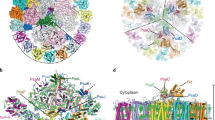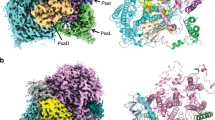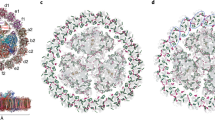Abstract
Cyanobacteria are abundant throughout most of the world's water bodies and contribute significantly to global primary productivity through oxygenic photosynthesis. This reaction is catalysed by two membrane-bound protein complexes, photosystem I (PSI) and photosystem II (PSII), which both contain chlorophyll-binding subunits functioning as an internal antenna1. In addition, phycobilisomes act as peripheral antenna systems, but no additional light-harvesting systems have been found under normal growth conditions. Iron deficiency, which is often the limiting factor for cyanobacterial growth in aquatic ecosystems2, leads to the induction of additional proteins such as IsiA (ref. 3). Although IsiA has been implicated in chlorophyll storage, energy absorption and protection against excessive light, its precise molecular function and association to other proteins is unknown. Here we report the purification of a specific PSI–IsiA supercomplex, which is abundant under conditions of iron limitation. Electron microscopy shows that this supercomplex consists of trimeric PSI surrounded by a closed ring of 18 IsiA proteins binding around 180 chlorophyll molecules. We provide a structural characterization of an additional chlorophyll-containing, membrane-integral antenna in a cyanobacterial photosystem.
This is a preview of subscription content, access via your institution
Access options
Subscribe to this journal
Receive 51 print issues and online access
$199.00 per year
only $3.90 per issue
Buy this article
- Purchase on Springer Link
- Instant access to full article PDF
Prices may be subject to local taxes which are calculated during checkout



Similar content being viewed by others
References
Nitschke, W. & Rutherford, A. Photosynthetic reaction centres: variations on a common structural theme? Trends Biochem. Sci. 16, 241–245 (1991).
Behrenfeld, M., Bale, A., Kolber, Z., Aiken, J. & Falkowski, P. Confirmation of iron limitation of phytoplankton photosynthesis in the equatorial pacific ocean. Nature 383, 508–511 (1996).
Straus, N. A. (ed.) in Advances in Photosynthesis Vol. 1 The Molecular Biology of Cyanobacteria (ed. Bryant, D. A.) 731–750 (Kluwer, Dordrecht, 1994).
Guikema, J. & Sherman, L. A. Organization and function of chl in membranes of cyanobacteria during iron starvation. Plant Physiol. 73, 250–256 (1983).
Burnap, R., Troyan, T. & Sherman, L. A. The highly abundant chlorophyll-protein complex of iron-deficient Synechococcus sp. PCC7942 (CP43′) is encoded by the IsiA gene. Plant Physiol. 103, 893–902 (1993).
Laudenbach, D. & Straus, N. A. Characterization of a cyanobacterial iron stress-induced gene similar to psbC. J. Bacteriol. 170, 5018–5026 (1988).
Leonhardt, K. & Strauss, N. An iron stress operon involved in photosynthetic electron transport in the marine cyanobacterium Synechococcus sp. PCC 7002. J. Gen. Microbiol. 138, 1613–1621 (1992).
Zouni, A. et al. Crystal structure of photosystem II from Synechococcus elongatus at 3.8 Å resolution. Nature 409, 739–743 (2001).
Pakrasi, H. B., Riethman, H. C. & Sherman, L. A. Organization of pigment proteins in the photosystem II complex of the cyanobacterium Anacystis nidulans R2. Proc. Natl Acad. Sci. USA 82, 6903–6907 (1985).
Park, Y.-I., Sandström, S., Gustafsson, P. & Öquist, G. Expression of the IsiA gene is essential for the survival of the cyanobacterium Synechococcus sp. PCC 7942 by protecting photosystem II from excess light under iron limitation. Mol. Microbiol. 32, 123–129 (1999).
Jordan, P. et al. Three-dimensional structure of cyanobacterial photosystem I at 2.5 Å resolution. Nature 411, 909–917 (2001).
Boekema, E. J. et al. Green plant photosystem I binds light-harvesting complex I on one side of the complex. Biochemistry 40, 1029–1036 (2001).
Lelong, C. et al. Characterization of a redox active cross-linked complex between cyanobacterial photosystem I and soluble ferredoxin. EMBO J. 15, 2160–2168 (1996).
Dekker, J. P., Boekema, E. J., Witt, H. T. & Rögner, M. Refined purification and further characterization of oxygen-evolving and Tris-treated photosystem II particles from the thermophilic cyanobacterium Synechococcus sp. Biochim. Biophys. Acta 936, 307–318 (1988).
La Roche, J. et al. Independent evolution of the prochlorophyte and green plant chlorophyll a/b light-harvesting proteins. Proc. Natl Acad. Sci. USA 93, 15244–15248 (1996).
Garczarek, L., Hess, W., Holtzendorff, J., van der Staay, G. & Partensky, F. Multiplication of antenna genes as a major adaptation to low light in a marine prokaryote. Proc. Natl Acad. Sci. USA 97, 4098–4101 (2000).
Boekema, E. J. et al. Supramolecular organization of the photosystem II complex from green plants and cyanobacteria. Proc. Natl Acad. Sci. USA 92, 175–179 (1995).
Karrasch, S., Bullough, P. & Ghosh, R. The 8.5 Å projection map of the light-harvesting complex I from Rhodospirillum rubrum revelas a ring composed of 16 subunits. EMBO J. 14, 631–638 (1995).
McDermott, G. et al. Crystal structure of an integral membrane light-harvesting complex from photosynthetic bacteria. Nature 374, 517–521 (1995).
Exss-Sonne, P., Toelle, J., Bader, K., Pistorius, E. & Michel, K.-P. The IdiA protein of Synechococcus sp. PCC 7942 functions in protecting the acceptor side of photosystem II under oxidative stress. Photosynth. Res. 63, 145–157 (2000).
Wenk, S.-O. & Kruip, J. Novel, rapid purification of the membrane protein photosystem I by high-performance liquid chromatography on porous materials. J. Chromatogr. B 737, 131–142 (2000).
Van Heel, M. & Frank, J. Use of multivariate statistics in analysing the images of biological macromolecules. Ultramicroscopy 6, 187–194 (1981).
Harauz, G., Boekema, E. & van Heel, M. Statistical image analysis of electron micrographs of ribosomal subunits. Methods Enzymol. 164, 35–49 (1988).
Hiyama, T. & Ke, B. Difference spectra and excitation coefficients of P700. Biochim. Biophys. Acta 267, 160–171 (1972).
Acknowledgements
We thank A. Kühl and F. Pfeil for technical assistance, and our colleagues M. Rögner and A. Trebst for discussions. Financial support of the Deutsche Forschungsgemeinschaft (J.K. and E.K.P.), Nederlandse Organisatie voor Wetenschappelijk Onderzoek (E.J.B.) and the Fonds der chemischen Industrie (J.K.) is gratefully acknowledged.
Author information
Authors and Affiliations
Corresponding authors
Rights and permissions
About this article
Cite this article
Boekema, E., Hifney, A., Yakushevska, A. et al. A giant chlorophyll–protein complex induced by iron deficiency in cyanobacteria. Nature 412, 745–748 (2001). https://doi.org/10.1038/35089104
Received:
Accepted:
Issue Date:
DOI: https://doi.org/10.1038/35089104
This article is cited by
-
Phylogenetic and spectroscopic insights on the evolution of core antenna proteins in cyanobacteria
Photosynthesis Research (2023)
-
Acclimation of the photosynthetic apparatus to low light in a thermophilic Synechococcus sp. strain
Photosynthesis Research (2022)
-
Role of an ancient light-harvesting protein of PSI in light absorption and photoprotection
Nature Communications (2021)
-
Physiological and spectroscopical changes of the thermophilic cyanobacterium Synechococcus elongatus under iron stress and recovery culture
Acta Physiologiae Plantarum (2021)
-
Structural basis for energy and electron transfer of the photosystem I–IsiA–flavodoxin supercomplex
Nature Plants (2020)
Comments
By submitting a comment you agree to abide by our Terms and Community Guidelines. If you find something abusive or that does not comply with our terms or guidelines please flag it as inappropriate.



